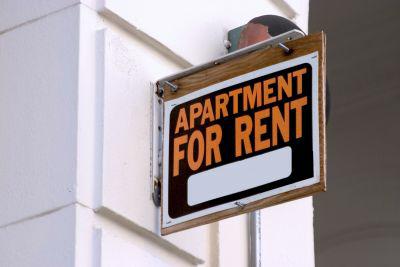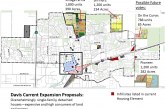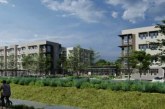 The annual report from UC Davis on the apartment vacancy rates and cost of rent came out last week. Not much changed, although the vacancy rate reportedly increased slightly since last fall to 3.4 percent while rents crept downward by an average of .55 percent, according to the annual survey from the UC Davis Office of Student Housing.
The annual report from UC Davis on the apartment vacancy rates and cost of rent came out last week. Not much changed, although the vacancy rate reportedly increased slightly since last fall to 3.4 percent while rents crept downward by an average of .55 percent, according to the annual survey from the UC Davis Office of Student Housing.
Last year, the apartment vacancy rate was 3.2 percent, and the average rent increase was 1.05 percent.
“Based on the responses received, the survey indicates that the market has remained flat since last year, both in terms of the vacancy and rental rates,” said Ramona Hernandez, associate director for business services in Student Housing.
According to the UC Davis survey, the average monthly rent this year for unfurnished two-bedroom apartments — which account for 44 percent of units in the survey — rose by 0.9 percent or $11, from $1,226 to $1,237.
The student housing office surveyed 163 apartment complexes with five or more rental units in October and November; 134 complexes responded. Out of a total of 8,724 units reported, 299.5 were vacant. The 29 complexes that did not respond to the survey have a total of approximately 320 units, UC Davis reported.
Enrollment was up for the fall of 2010 with a record-setting 32,290, which was up only slightly from the 32,153 (0.4 percent increase) from the fall of 2009.
According to the release, “Not all students attend classes on the Davis campus itself, and enrollment averaged over the three academic quarters is typically lower than fall enrollment.”
According to information provided in the release, “UC Davis offers housing to all freshman and transfer students who request it. The university has about 4,711 students living in residence halls. An additional 476 families and single graduate students live in Orchard and Solano parks, and 1,436 students live in privately managed housing complexes on campus, such as Russell Park and The Colleges at La Rue.”
How did vacancy go up while enrollment also rose? Apparently it had to do with UC Davis making available about 600 additional beds in the new Wall, Campbell and Potter residence halls at Dairy and La Rue roads.
The university will then discontinue use of about 12 buildings comprising of 800 beds and another two buildings comprising 495 beds. At those sites, plans are under way to construct about a 1200-bed housing project that would open in the fall of 2014.
Also, in the fall of 2011, the privately-developed West Village community is scheduled to open its first 315 student apartments accommodating about 850 beds. In the new year, a temporary leasing office at 409 Third Street in downtown Davis will help show off floor plans and interior amenities to prospective residents.
West Village plans to build an additional 345 student apartment units accommodating 1,130 beds; half are planned to open in 2012 and the rest in 2013.
What all this means is not completely clear. If the university continues to expand, then the university, along with the city, will have to expand the amount of rental housing.
There are few plans in the city to do that, and it seems problematic. Should the ConAgra site be developed, the site seems geared more for so-called workforce housing than student housing.
There has been a big push for senior housing in recent years, led by the developer-driven group CHA.
However, there has been little collaboration between the city and UC Davis on housing for students, which would appear to be a large need as the vacancy rate is still very low, student populations are increasing and UC Davis is building on the periphery over ag land to accommodate student housing needs.
The city has talked about wanting to partner with UC Davis on bringing business and start-ups to the community, but there appears to be a disconnect on the issue of housing. Few if any of the recent development proposals have sought to address this critical need, despite several councilmembers in the 2008 elections paying lip service to the issue.
—David M. Greenwald reporting






It would be interesting to get similar information from the rest of Yolo County (Woodland, Winters, West Sac) & Dixon. If vacancy rate goes down in Davis, does that mean more students look for housing in neighboring communities?
Davis isn’t a hermetically-sealed community.
The UC Davis report is unique in that they survey smaller units as well as larger ones. So it is hard to find a direct comparison of Davis vacancy rate vs nearby communities. Here is a site that gives you price information:
[url]http://www.apartmentratings.com/rate?a=MSAAvgRentalPrice&msa=6922[/url]
Pretty amazing that one-room unit rents have still increased, even in the current housing market. At least larger units are finally dropping.
UC Davis has added 600 beds this year. They will remove 1295, then nearly replace them with 1200. West Village will add 850 beds. So the net increase in beds by UC will be about 1450 beds. I don’t know of any additional projects they have scheduled over this decade.
UC enrollment projections have an additional 2310 undergraduate students and 1760 graduate students at UC Davis by 2020.
The current building level by UC will not provide enough beds for their projected enrollment increase.
This site ([url]http://facts.ucdavis.edu/student_population_headcount_fall.lasso[/url]) lists all UCD enrollment statistics since 1999.
One thing which is interesting over the last decade: most of the growth in the undergraduate population is among juniors and seniors with almost no change among freshmen and sophomores. I presume that is because families have decided it makes financial sense to send their kids to JCs for two years before paying the high UC fees.
Don S. — ever since I came to Davis in 1987, U.C. has predicted much, much higher enrollment increases than that which actually materialized. Maybe this time will be different, but given the fiscal situation for the foreseeable future, I doubt it.
I don’t think UC has done all that bad a job with their projections.
From an enrollment projection update document in 2002, UC provided the following range of revisions to their 1999 enrollment projections for the year 2010:
UC High Projection 246,900
UC Constant Participation Projections 229,500
DOF Series 2001 Projection 223,000
UC 1999 Plan 217,500
UC Low Projection 204,400
(sorry, I can’t make the link work for the quickview of this pdf).
2009 – 10 actual enrollment systemwide: 230,528. (Source: http://www.cpec.ca.gov/OnLineData/GenerateReport.ASP)
Depending on which model you look at, UC has met or exceeded its projections systemwide.
Total projected enrollment for Davis over the next decade:
2010: 32,310
2020: 36,780
(Source: http://repository.ucop.edu/cgi/viewcontent.cgi?article=1000&context=enrllmt_lrp_reports)
The 2010-11 UC budget calls for a “multi-year plan to reduce total enrollments by 8,000 –10,000 students” systemwide to deal with the current budget shortfall. Nevertheless, the longterm expectation statewide is for a slowing increase in enrollment, not a decrease in enrollment, over the next decade.
Housing growth by UC will not cover the increased housing needs UC has generated by growth over the last decade, so even when they build everything currently planned there will still be a vacancy rate less than 5%.
Even if UC Davis doesn’t grow at all (unlikely), there is still not enough rental housing here to make rents reasonable. Non-student Davis renters such as my children and employees pay a premium because of the lack of rental housing.
No housing developments should be approved by the city council until this disparity is recognized and factored into housing growth. As I’ve said before, renters and young adults are a significant interest group that is under-represented on commissions, in this case in consideration of housing issues. Davis does not need 610 high-end houses. Davis needs more rental housing for young adults and moderate- to low-income renters, and has needed more rental housing for well over a decade.
The vacancy rate is the best metric we have. Until it is 5%, no other housing should have higher priority.
Don Shor: “No housing developments should be approved by the city council until this disparity is recognized and factored into housing growth.”
I think you make a good point, but are you telling me the city council does not factor in the need for rental housing when making development decisions?